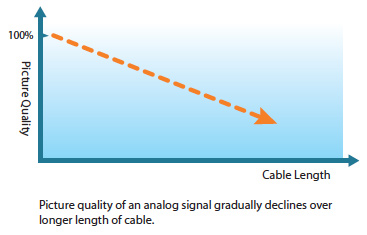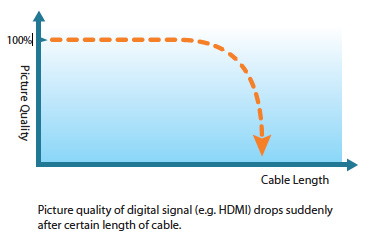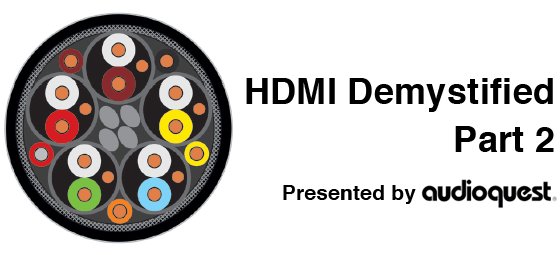This is part two of a two part feature presented by AudioQuest. Missed the first half? Read HDMI Demystifed Part 1 for an understanding on what HDMI is and how it works.
As we learned in Part 1, High-Definition Multimedia Interface, or HDMI, is a digital audio, video and control signal format defined by seven of the largest consumer electronics manufacturers.
HDMI Cables
 All HDMI cables are made up of 19 individual conductors. Many of these wires perform multiple tasks and transmit large amounts of data, so the quality of the conductors, precision of the geometry, and the quality of the termination all affect the ability of the cable to properly implement its tasks.
All HDMI cables are made up of 19 individual conductors. Many of these wires perform multiple tasks and transmit large amounts of data, so the quality of the conductors, precision of the geometry, and the quality of the termination all affect the ability of the cable to properly implement its tasks.
For the most part, unlike HDMI enabled components, HDMI cables do not have features, they have capacity (often described as speed and measured in Gbps). The one exception to this is the new Ethernet feature, which requires a Ethernet-compatible cable. Other than this exception, the cable does not care what the resolution, color depth, or refresh rate of the signal is, as long as the data that makes up the signal is not too large for the cable to pass. HDMI LLC has approved two different categories of cable based on their respective speed ratings.
 High Speed: meets or exceeds the maximum current data rate for HDMI of 10.2 Gbps,capable of transmitting 100% of the data required for all of HDMIs current audio/video features, including Blu-ray 3D. Nearly all short length cables meet or exceed this category. Very high quality cables will meet this specification for lengths up to about 10m. For the most part, longer length HDMI cables can only meet the High Speed specification with the use of active-circuit equalization or amplification.
High Speed: meets or exceeds the maximum current data rate for HDMI of 10.2 Gbps,capable of transmitting 100% of the data required for all of HDMIs current audio/video features, including Blu-ray 3D. Nearly all short length cables meet or exceed this category. Very high quality cables will meet this specification for lengths up to about 10m. For the most part, longer length HDMI cables can only meet the High Speed specification with the use of active-circuit equalization or amplification.
 Standard Speed: meets or exceeds the minimum HD data rate of 2.25 Gbps, the amount needed to transmit 1080i or 720p. Many Standard Speed cables are capable of higher data rates that allow for features such as 1080p or broadcast 3D (which requires about 4 Gbps), but do not have the capacity to achieve the High Speed rating. A well-made moderate length (such as 12m) cable may even be able to pass Blu-ray 3D, but still be rated as Standard Speed. Even the best long length HDMI cables are currently limited to a Standard Speed rating.
Standard Speed: meets or exceeds the minimum HD data rate of 2.25 Gbps, the amount needed to transmit 1080i or 720p. Many Standard Speed cables are capable of higher data rates that allow for features such as 1080p or broadcast 3D (which requires about 4 Gbps), but do not have the capacity to achieve the High Speed rating. A well-made moderate length (such as 12m) cable may even be able to pass Blu-ray 3D, but still be rated as Standard Speed. Even the best long length HDMI cables are currently limited to a Standard Speed rating.
Since the ability for an HDMI cable to pass Ethernet requires an additional twisted-pair of conductors inside the cable, HDMI has added two additional cable types. These are High Speed with Ethernet and Standard Speed with Ethernet.
To recap, there are four cable types approved for home use by HDMI LLC:
- Standard Speed
- High Speed
- Standard Speed with Ethernet
- High Speed with Ethernet
Other speed rating systems are on the market, but are not approved by HDMI LLC and are primarily for marketing purposes. Only the four cable types listed above are certified by HDMI LLC. Also be wary of cable manufacturers that tout incredibly high data rates or speed ratings on very long length cables. These manufacturers are usually labeling long length cables based on results obtained from testing shorter versions of the cable.
Cable Length, Data Rate, and the Cliff Effect:
In earlier sections, length is often mentioned as a concern for HDMI cables. The reason for this is that HDMI cables function differently than analog cables, like component video. When a component video cable is run longer, it will pick up noise and lose signal along the way in a very linear fashion. It is unrelated to the amount of signal being sent, and will result in visible noise and loss of detail and brightness. A better component video cable will lessen this effect and give you better performance by reducing the amount of distortion in the cable and shielding the signal from outside noise.

HDMI cables transmit packets of digital data along twisted pairs of wire. While there is still noise and loss, as long as enough of the signal gets to the television, error correction inside the TV will fill in the missing pieces and give you a good clean picture that is difficult to distinguish from a picture with fewer errors. If loss is too great, the image will appear to sparkle or you will lose picture completely. This is called the cliff effect, which will be explained further below.

The primary factors that affect any given quality level of HDMI cables ability to provide a picture, are the amount of data being sent, and the length of the cable. Higher data rates bump up against the capacity of the cable, a capability which very simply diminishes with length. A cable that may be capable of passing 1080i at 30m may not be able to pass 1080p until it is as short as 15m, and will not be able to pass 1080p 3D signals or Deep Color signals.
The Premium Cable Argument:
More than any other cable category, premium HDMI cables are maligned for being not worth it. This is mostly due to a fundamental misunderstanding of how digital works as well as oversight of all the functions an HDMI cable is tasked with. That said, there is an element of truth to what is often said about HDMI cables. Two short length (lets say 2m) cables of different qualities connected to identical systems will often be difficult to distinguish from one another in picture quality. This is because the error rate is very low on a short length cables and the HDMI signal contains extra bits for error correction. Sharp eyes may see differences in brightness, or errors when a lot of motion is present. These video differences can be more pronounced as lengths increase, but are not always as clear as night and day. Premium cables are capable of reliably going longer distances at higher data rates. Because of this, most of the grumbling and pushback from naysayers is in regards to shorter cables.
It should be said though, that errors do still exist on shorter cables and error correction is never ideal. A premium cable, even in shortlengths, will result in less error correction and a measurably better signal, even though the human eye might be easily fooled.
While the human eye is easily fooled, the human ear is in many ways much more perceptive. Think of this

